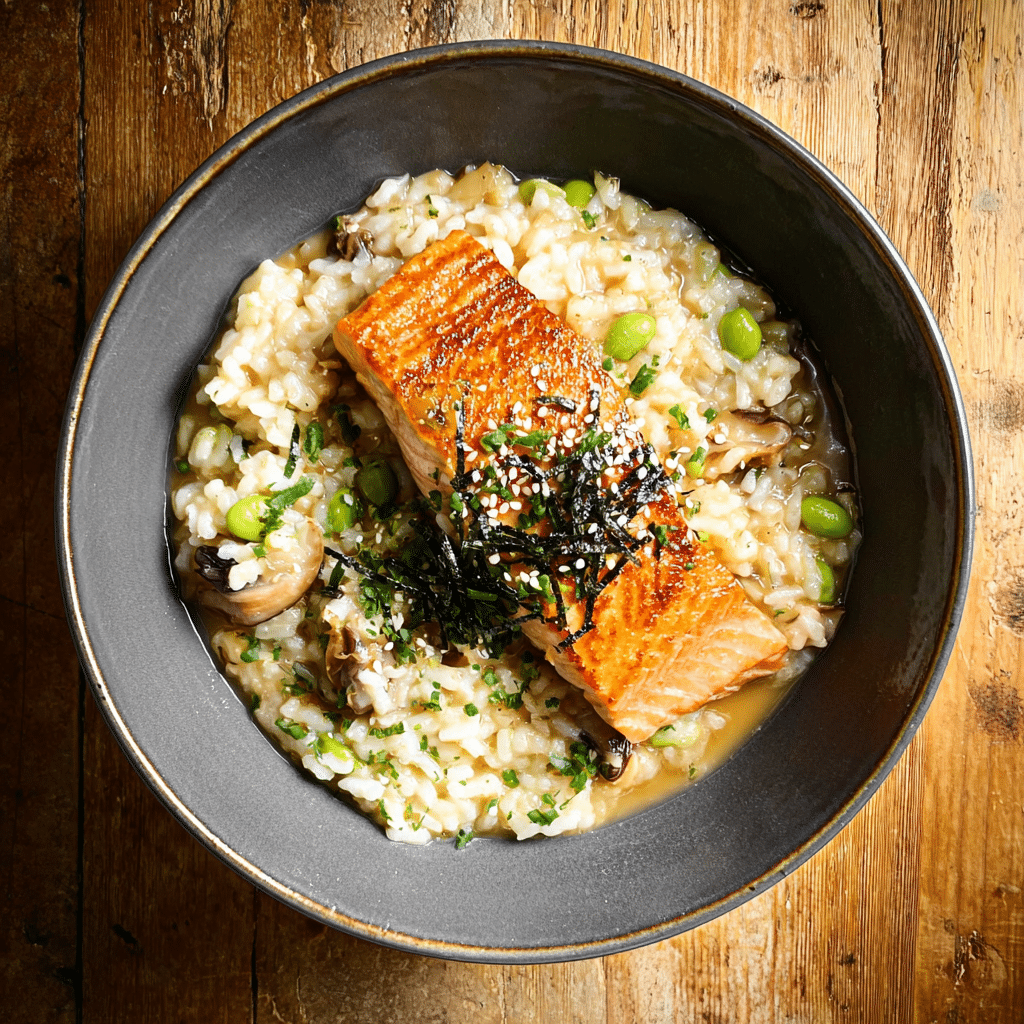The fusion of Japanese ingredients with a classic Italian cooking technique creates a dish that is both familiar and exciting. This Japanese-Style Risotto with Seared Salmon is a culinary mashup where creamy miso-laced rice meets the crisp perfection of pan-seared salmon.
With notes of ginger, garlic, soy, and miso, every bite is packed with umami depth. The edamame adds texture and color, while scallions and sesame seeds provide a refreshing contrast. Whether you’re hosting a cozy dinner or treating yourself to a weeknight gourmet experience, this dish delivers comfort with a refined edge.
Full Recipe
Ingredients:
-
1 cup Arborio rice
-
1 tbsp sesame oil
-
1 shallot, finely chopped
-
2 garlic cloves, minced
-
1-inch piece of ginger, grated
-
1 tbsp white miso paste
-
3 cups dashi broth (or low-sodium vegetable broth)
-
1 tbsp soy sauce
-
1 tbsp rice vinegar
-
1 tbsp mirin
-
1/2 cup frozen edamame
-
1/4 cup chopped scallions
-
Salt and black pepper to taste
-
2 salmon fillets, skin on
-
1 tbsp vegetable oil (for searing)
-
Toasted sesame seeds and sliced nori for garnish
Directions:
-
In a medium saucepan, warm sesame oil over medium heat. Add the shallot, garlic, and ginger, and sauté for 2-3 minutes until fragrant.
-
Stir in the Arborio rice and cook for 1-2 minutes, allowing the rice to slightly toast.
-
Add the miso paste and mix well until it coats the rice.
-
Begin adding the broth gradually, 1/2 cup at a time, stirring frequently. Let the rice absorb each addition before adding more. This should take around 20 minutes.
-
While the risotto is cooking, heat vegetable oil in a skillet over medium-high heat. Season the salmon with salt and pepper.
-
Place the salmon fillets skin-side down and sear for 4-5 minutes until the skin is crispy. Flip and cook for another 3-4 minutes until the salmon is just cooked through. Remove from heat and let rest.
-
When the risotto is creamy and tender, stir in soy sauce, rice vinegar, mirin, and edamame. Adjust seasoning to taste.
-
Plate the risotto in shallow bowls, top with seared salmon, and garnish with scallions, sesame seeds, and nori strips.
Prep Time: 10 minutes | Cooking Time: 25 minutes | Total Time: 35 minutes
Kcal: 475 kcal | Servings: 2 servings
Japanese-Style Risotto with Seared Salmon
A Fusion of Culinary Traditions
Japanese-Style Risotto with Seared Salmon is a dish that masterfully blends two distinct culinary traditions—Italian and Japanese—into one harmonious and elevated meal. At its heart, this recipe takes the technique of traditional Italian risotto-making, known for its creamy texture and rich flavors, and infuses it with signature Japanese ingredients like miso, dashi, soy sauce, mirin, and edamame. The final touch, a beautifully seared salmon fillet, adds a luxurious protein component that enhances both the taste and visual appeal of the dish. This fusion-style risotto is not only comforting and deeply flavorful but also an elegant representation of how international cuisines can be respectfully combined to create something new and delightful.
The Inspiration Behind the Dish
The inspiration for Japanese-Style Risotto with Seared Salmon comes from a desire to explore cross-cultural cuisine while maintaining balance and integrity in flavor. Risotto, a Northern Italian staple, is known for its slow-cooked, creamy rice base often enriched with butter, wine, and cheese. By replacing these Western elements with Japanese umami-rich components such as white miso paste and dashi broth, the recipe opens the door to a lighter yet deeply savory version of risotto. The addition of salmon, a fish revered in Japanese cuisine for its richness and versatility, not only complements the miso rice but adds substance and depth to the overall dish. This culinary approach appeals to adventurous cooks and eaters alike, offering both familiarity and excitement in every bite.
The Role of Umami
Umami, often referred to as the fifth taste, plays a central role in this dish. Ingredients like miso paste, soy sauce, and dashi broth are inherently umami-rich, delivering that savory depth that makes this dish stand out. The miso paste, in particular, provides a fermented complexity, while the dashi adds a delicate seafood essence from ingredients like kombu (kelp) and bonito flakes. Soy sauce enhances the savory notes even further, tying all the components together in a cohesive flavor profile. Combined, these ingredients transform the Arborio rice into a creamy, umami-laden base that doesn’t rely on traditional Western fats like butter or cream for its richness.
Texture and Contrast
Texture is another element that elevates this recipe from everyday comfort food to something special. The creamy risotto base is smooth and luscious, almost melting on the tongue. In contrast, the salmon is pan-seared until the skin turns crispy, providing a delightful crunch that plays beautifully against the soft rice. Edamame beans scattered throughout the risotto offer bursts of freshness and a slight bite, while scallions lend brightness and a gentle onion-like sharpness. Toasted sesame seeds and slivers of nori, used as garnish, not only add a decorative touch but also enhance the crunch and flavor complexity of the final presentation.
Versatility and Customization
One of the strengths of this recipe is its adaptability. While the base of Arborio rice and miso can remain constant, various vegetables or proteins can be substituted depending on what’s available or in season. For instance, tofu can be used in place of salmon for a vegetarian version, or shrimp for a seafood twist. Additional vegetables such as shiitake mushrooms, baby spinach, or bok choy can be added to enhance the nutritional profile or cater to personal preferences. You can even experiment with different types of miso—white for a mild sweetness or red for a stronger, more fermented flavor. This flexibility makes the dish suitable for a range of diets and occasions.
Nutritional Value
In addition to its culinary appeal, Japanese-Style Risotto with Seared Salmon offers notable health benefits. Salmon is an excellent source of high-quality protein and is rich in omega-3 fatty acids, which support heart and brain health. Miso, being a fermented product, is beneficial for gut health and is known to contain various vitamins and minerals. Edamame contributes plant-based protein, fiber, and antioxidants, making the dish both satisfying and nutritionally balanced. By avoiding heavy creams or cheeses typically found in traditional risotto, this version remains lighter while still delivering a creamy texture and full flavor.
Cooking Techniques That Matter
Perfecting this recipe lies in the cooking techniques. The risotto method requires patience, as the broth must be added gradually and stirred frequently to achieve the signature creaminess. This slow cooking process allows the rice to release its starches, resulting in the luxurious texture risotto is known for. Meanwhile, searing the salmon properly ensures that the skin becomes crisp while keeping the interior moist and tender. Using high heat and allowing the salmon to cook undisturbed helps achieve that desired contrast in textures. Mastering these techniques brings out the best in each ingredient, showcasing the beauty of both culinary traditions.
Ideal Occasions for Serving
Japanese-Style Risotto with Seared Salmon is ideal for both casual and formal settings. It makes for a refined dinner party entrée, perfect for impressing guests with your global culinary skills. At the same time, it’s simple enough to prepare for a comforting weeknight dinner. Its warm and creamy nature makes it especially suitable for colder months, offering a bowl of comfort that is both hearty and wholesome. However, its bright flavors and fresh ingredients also make it a wonderful option year-round, especially when paired with a crisp white wine or green tea for a complete dining experience.
Presentation and Plating Tips
Presentation plays a vital role in the overall appeal of this dish. To elevate the visual aspect, consider serving the risotto in shallow white bowls that highlight the colors and textures of the ingredients. Place the salmon fillet gently on top of the rice, allowing the crispy skin to remain visible. Sprinkle with finely sliced scallions, toasted sesame seeds, and nori strips to add height, color, and crunch. A light drizzle of sesame oil or a few drops of soy glaze can enhance the appearance and add extra layers of flavor. Thoughtful plating can make a home-cooked meal feel like a restaurant-quality experience.
A Balanced Culinary Experience
This dish stands out not only for its delicious flavor but also for the balanced culinary experience it provides. It combines protein, complex carbohydrates, healthy fats, and a variety of micronutrients, making it a well-rounded meal. The richness of the miso and the creaminess of the rice are balanced by the brightness of vinegar and the freshness of herbs and vegetables. The crispy salmon adds depth and satisfaction, while the garnishes bring in layers of texture and umami. This balance makes the dish feel indulgent without being overly heavy—a key reason why it continues to be a favorite among modern home cooks.
Cultural Appreciation Through Cuisine
Dishes like Japanese-Style Risotto with Seared Salmon remind us that cooking is not just about nourishment; it’s also a form of cultural storytelling. By respectfully blending culinary techniques and ingredients from different cultures, we can create new dishes that honor their origins while also reflecting our creativity and taste. In this case, we pay homage to both Italian and Japanese culinary traditions, merging them into something uniquely modern. It’s a celebration of cultural appreciation and innovation, a dish that invites exploration and understanding through the universal language of food.
Conclusion
Japanese-Style Risotto with Seared Salmon is more than just a delicious fusion dish—it’s a testament to the power of culinary creativity and cultural synergy. By blending the creamy, comforting texture of risotto with the bold, umami-rich flavors of Japanese ingredients and the crispy perfection of pan-seared salmon, this recipe offers a multi-dimensional dining experience. It’s versatile, nourishing, visually stunning, and suitable for any occasion. Whether you’re an adventurous eater or someone looking to break free from traditional recipes, this dish provides an inspiring path forward in the kitchen. Once you’ve made it, you’ll likely return to it again and again—not just for the taste, but for the joy of crafting something truly special from global influences.






